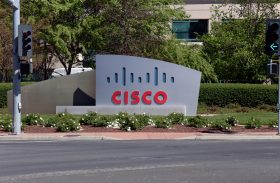Cisco Reports Upbeat Earnings, Despite Supply Constraints

This week’s earnings report from Cisco Systems (CSCO) surprised analysts by showing unexpected strengths in meeting key industry demands and challenges.
In its 3Q FY2021 report May 19, Cisco reported $12.8 billion in quarterly revenues, up 7% year-over-year — the first increase in several quarters, bolstered by an extra week of revenue during the quarter. Non-GAAP net income was $3.5 billion, or $.83 earnings per share (EPS). On a non-GAAP basis, total gross margin was 66%, flat year-over-year but still praised by analysts as being among the highest of the vendor's margin reports in 15 years.
Cisco expects the good revenue news to continue, with sales growing 6% to 8% next quarter. Still, Cisco guided down for EPS next quarter. The company expects $.81 to $.83 per share. Gross margins should fall too, between 64% and 65%. On an earnings call with financial analysts, execs blamed the “similar component shortage supply issues as our peers,” which has forced Cisco to start raising prices and post lower gross margins to account for the higher costs of fulfilling demand.
Cisco Shows a Strong Hand
Overall, Cisco’s report showcased the demand that’s growing as a result of widespread digital transformation in the wake of the COVID-19 pandemic. The report also revealed some of Cisco’s surprising strengths in meeting market demand, particularly evident in the following areas:
Campus switching. Growth in Cisco’s infrastructure hardware was led by strong sales of campus switches, reflecting increasingly distributed corporate networking schemes — and echoing similar claims by rival Arista (ANET). “[S]witching revenue increased overall with growth in campus, driven by strong double-digit growth of our Catalyst 9000 products,” said CFO Scott Herren on this week’s call.
Service provider hardware. During the quarter, Cisco saw 17% growth in sales of hardware, particularly routers, to service providers off all kinds — including telcos and hyperscale public cloud providers. That last segment represents progress for Cisco.
”[W]e didn't play in the web-scale space five years ago,” said Cisco CEO Chuck Robbins on the earnings call. “And now … that was almost a quarter of our service provider business again this quarter and … it grew over 25% this quarter against a quarter a year ago that was in excess of 70% growth. So it's still accelerating.”
Software and service subscriptions. Cisco is moving toward offering more software and services on a subscription basis. “Software revenue was $3.8 billion and subscriptions were 81% of total software revenue, up 7 points year on year,” said CFO Herren. Service revenue, which also is billed on a recurring basis, was up 8% for a total of $3.7 billion. Total product revenue, for the record, was $9.1 billion, up 6%.
Silicon One. Instead of sticking to its initial intent to create routing chips, Cisco has pivoted — successfully, it seems — to offering multiple flavors of switch chips to webscale cloud providers. At least one analyst sees this move as positive. “Cisco’s strategy appears to be working…. The traction with Silicon One provides another validation of [Cisco’s] investment in hardware,” stated Simon Leopold and colleagues at Raymond James in a note.
Cisco Predicts the Future
Throughout this week’s call, Cisco execs cited several trends they see building in the markets they serve:
Security. “We had a record quarter [in security], surpassing $875 million in revenue, up 13%,” said CEO Robbins. “100% of the Fortune 100 are using Cisco security solutions. These customers are increasingly deploying our zero-trust and … SASE architectures…”
400G. Cisco claims to have grown its customer list for 400-Gbit/s Ethernet products by 50% last quarter, chiefly among webscale cloud providers. But Robbins acknowledges it’s early days for the technology, which remains a long-term growth driver.
5G. “[O]ur carrier customers are exploring new architectures to realize the full potential of 5G,” said Robbins. Things are starting to play out in 5G, he said, though it remains another long-term driver.
WiFi 6. Cisco sees a range of applications for advanced WiFi. “Customers are turning to us to help them create the trusted workplace of the future with WiFi access points, video endpoints, cameras, and IoT sensors,” said Robbins. “We are enabling operations teams to remotely monitor workplace conditions for a safe return to office.” He also sees a link between WiFi 6 and campus switching, underscoring the migration to distributed remote sites for many enterprises.
Overall, Cisco’s report drew positive analyst response. In a note titled “Not Your Father’s Cisco,” MKM Partners executive director Fahad Najam wrote: “Mgmt's confident tone and the solid underlying demand trends offer strong support for our view that investors have not fully appreciated the transformation CSCO has undertaken over the past four years under the leadership of CEO Mr. Chuck Robbins.”
It looks as though Cisco may have turned a corner. Still, the same market forces driving Cisco sales are pushing revenue for other players. Archrival Juniper (JNPR) is focusing on automation and AI and recently released a compelling SASE solution. Newcomers abound in all the areas Cisco addresses. But gauging by this report, Cisco has gained new momentum to compete.



